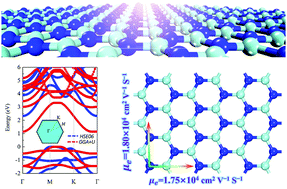Intriguing electronic insensitivity and high carrier mobility in monolayer hexagonal YN†
Abstract
Two-dimensional (2D) materials have extraordinary properties and multifunctional applications; thus, prodigious efforts have been made in the exploration of novel 2D materials. In this study, 2D hexagonal YN (h-YN) is predicted based on theoretical calculations. By assessing its phonon spectrum, ab initio molecular dynamics and elastic constants, the h-YN monolayer is proven to exhibit satisfying thermal, dynamic and mechanical stability. Unique from most of the reported 2D transition metal mononitrides, which exhibit metallic characteristics, monolayer h-YN is a semiconductor with an indirect bandgap of 2.322 eV. In particular, the electronic structures of h-YN present unusually insensitive responses to tensile or compressive strain due to valence orbital hybridization. Carrier mobility calculations suggest that monolayer h-YN possesses a high electron mobility of up to 104 cm2 V−1 s−1 and hole mobility of up to 103 cm2 V−1 s−1 in the zigzag and armchair orientations. Moreover, few-layer h-YN displays evident semiconductor performances and dispersive conductive bands, indicating light electron effective masses and excellent electron transport capabilities. This pronounced carrier mobility, insensitive electronic responses to strain and light electron effective masses of its few-layer structures demonstrate that h-YN is a promising candidate in future nanoscale electronic devices in high-strain conditions.



 Please wait while we load your content...
Please wait while we load your content...